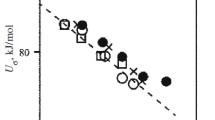Conclusions
-
1.
The yield criteria recommended for polymers, in which the effect of hydrostatic pressure is formally reflected, are insufficiently reliable and can be used in engineering computations only for special cases of loading.
-
2.
The strength criteria of polymer materials should be included as an independent parmeter of the third invariant of the stress deviator. To define the structure of the criterion more precisely, it is necessary to acquire in a rational manner experimental data on the mechanical properties of polymers in a complex stressed state.
-
3.
A discontinuity in the convexity of the limiting surface, which is associated with structural changes in the material and with a change in the deformation mechanisms of the polymers at high levels of hydrostatic pressure, is observed experimentally.
Similar content being viewed by others
Literature Cited
S. B. Aibinder, K. I. Alsne, É. L. Tyunina, and M. G. Laka, Properties of Polymers Under High Pressures [in Russian], Khimiya, Moscow (1973).
J. A. Sauer, “Deformation, yield, and fracture of polymers at high pressure”, Polym. Eng. Sci.,17, No. 3, 150–164 (1977).
K. D. Pae and S. K. Bhateja, “The effect of hydrostatic pressure on the mechanical behavior of polymers”, J. Macromol. Sci.: Rev. Macromol. Chem.,13, No. 1, 1–75 (1975).
S. A. Tsygankov, N. P. Demechuk, and G. É. Mesh, “On the hydroextrusion of polymers”, in: Modeling the Structure and Properties of Polymers [in Russian], ONPO “Plastpolimer”, Leningrad (1981), pp. 86–91.
P. Bridgeman, Investigation of Large Plastic Deformations and Rupture [Russian translation], IL, Moscow (1955).
P. B. Bowden and S. Raha, “The formation of microshear bands in polystyrene and polymethylmethacrylate, Philos. Mag.,22, No. 177, 463–482 (1970).
K. D. Pae, “The macroscopic yielding behavior of polymers in multiaxial stress fields”, J. Mater. Sci.,12, No. 8, 1209–1215 (1977).
K. B. Baknell, Shock-Resistant Plastics [Russian translation], Khimiya, Leningrad (1981).
S. S. Sternstein and L. Ongchin, “Yield criteria for plastic deformation of glassy high polymers in general stress fields”, Am. Chem. Soc. Polym. Prepr.,10, No. 2, 1117–1124 (1969).
R. Raghava, R. M. Caddell, and G. S. Y. Yeh, “The macroscopic yield behavior of polymers”, J. Mater. Sci.,7, No. 2, 326–343 (1973).
G. S. Pisarenko and A. A. Lebedev, Deformation and Strength of Materials in a Complex Stressed State [in Russian], Naukova Dumka, Kiev (1976).
I. I. Gol'denblat and V. A. Kopnov, “General strength criteria of isotropic media”, Mekh. Polim., No. 2, 251–261 (1971).
A. A. Silano, S. K. Bhateja, and K. D. Pae, “Effect of hydrostatic pressure on the mechanical behavior of polymers: polyurethane, polyoxymethylene and branched polyethylene”, Int. J. Polym. Mater.,3, No. 2, 117–131 (1974).
A. A. Silano, K. D. Pae, and J. A. Sauer, “Effect of hydrostatic pressure on shear deformation of polymers”, J. Appl. Phys.,48, No. 10, 4076–4084 (1977).
J. A. Sauer, D. R. Mears, and K. D. Pae, “Effect of hydrostatic pressure on the mechanical behavior of polytetrafluorethylene and polycarbonate”, Eur. Polym. J.,6, No. 7, 1015–1032 (1970).
K. D. Pae and J. A. Sauer, “Shear deformation under hydrostatic pressure of polytetrafluorethylene and polycarbonate,” in: High Pressure Science and Technology, Sixth AIRAPT Conference, Vol. 2 (1979), pp. 512–518.
A. Ya. Gol'dman, Strength of Structural Plastics [in Russian], Mashinostroenie, Leningrad (1979).
H. N. Yoon, K. D. Pae, and J. A. Sauer, “The effect of combined pressure-temperature on mechanical behavior of polypropylene”, J. Polym. Sci.: Polym. Phys. Ed.,14, No. 9, 1611–1627 (1976).
A. Ya. Gol'dman and S. A. Tsygankov, “Predicting creep deformations of polymer material in a complex stressed state”, Mekh. Kompozitn. Mater., No. 6, 1088–1093 (1980).
A. A. Vakulenko, “On relations between stresses and strains in inelastic media”, Issled. Uprug. Plastich., No. 1, 3–35 (1961).
V. I. Levitas, “On certain inelastic-strain models of materials. Reports 1 and 2”, Probl. Prochn., No. 12, 70–83 (1980).
Additional information
ONPO “Plastpolimer.” Institute of Strength Problems, Academy of Sciences of the Ukrainian SSR, Kiev. Translated from Problemy Prochnosti, No. 3, pp. 62–66, March, 1983.
Rights and permissions
About this article
Cite this article
Gol'dman, A.Y., Freidin, A.B. & Lebedev, A.A. Dependence of the yield point of polymer materials on hydrostatic pressure and certain plasticity criteria. Strength Mater 15, 373–377 (1983). https://doi.org/10.1007/BF01523186
Received:
Issue Date:
DOI: https://doi.org/10.1007/BF01523186




